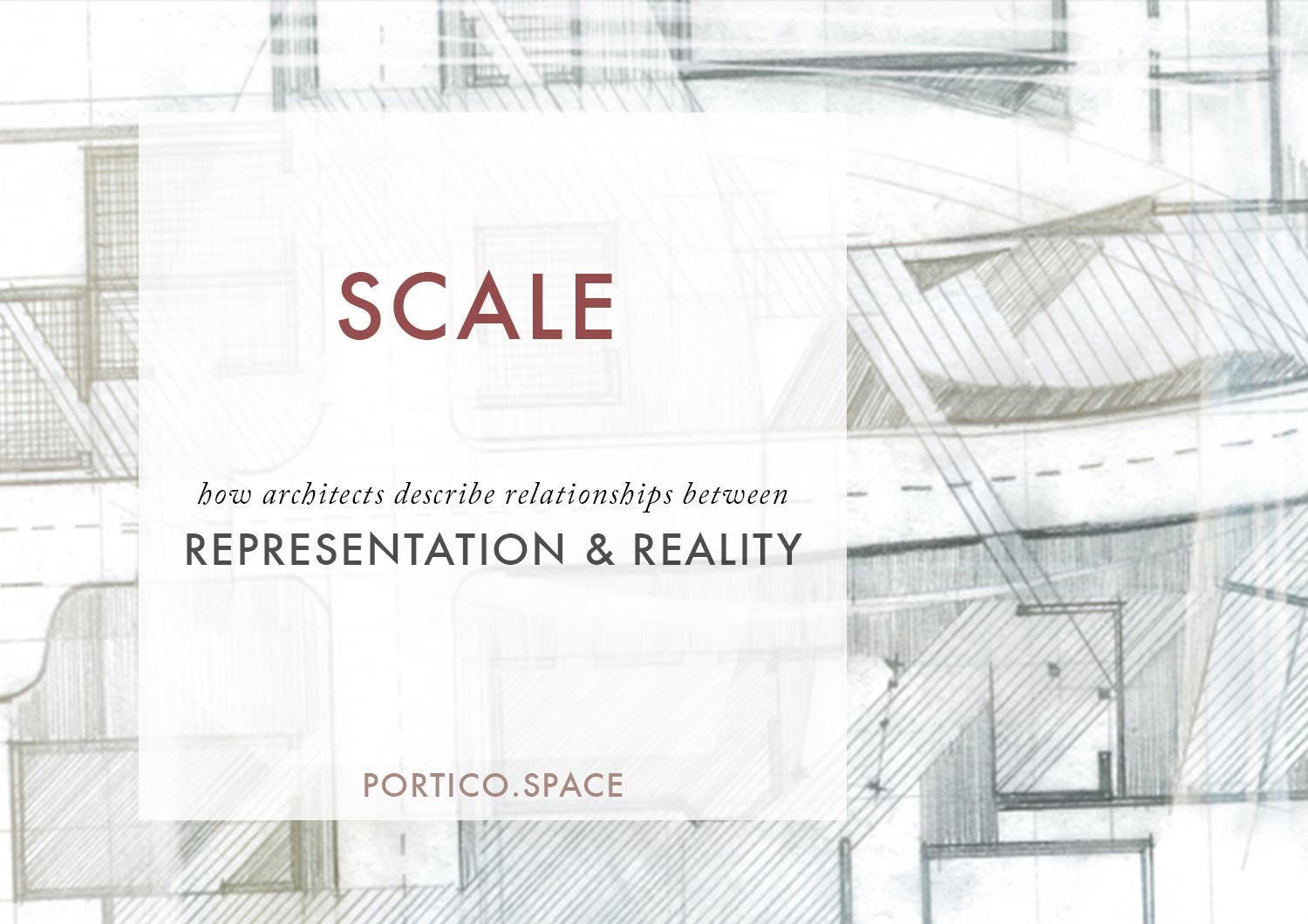DRAWING FOR ARCHITECTS BASICS: SCALE
Scale allows us to understand the relationship between a representation - a drawing or model - and reality. Being able to draw accurately to scale, and to shift fluidly between scales, is one of the most important aspects of architectural drawing and spatial design.
To SCALE
'To scale' simply means that every element in a drawing or model is in the same proportion, with the same relationships as than the real (or proposed) thing - but, that it is smaller or larger by a certain percentage.
“Scale is how we relate our representations to reality; a magic correlation of mathematics with experience.”
But when we say a drawing is 'to scale', we usually don't just mean that the proportions correct.
Rather, we are often trying to confirm that what we are looking at is shown at a common scale, one that we know and understand, so that we can translate the spatial qualities in our mind and imagine occupying the spaces.
We represent scales using the mathematical way to show relationships: ratios. For example, a drawing might be at 1:100 (said one to one hundred). I'll give you more information on how to use ratios later in this post.
Or skip down to 'doing the maths' if you can't wait!
Using Scale
Why do architects use Scale?
At a basic level, the main point of scaling is to ensure to we are able to represent reality on a piece of paper, or in a model.
Fundamentally, this is based in the practicality of making the drawing fit on your page, or your model fit on your table, or be light enough to lift. In other words, the reason we we don’t often draw at 1:1, is simply because the real drawing would often be too big, and take the same effort as actually building the building!
There are, of course, ways around this. For example, if you have a very long building, whose section does not fit on a single page, you might be able to use break lines to ‘cut out’ and omit the central or more repetitive sections of the building. If you are using this technique, be sure not to omit any aspects which are critical to the understanding or construction of the building, such a changes in levels or materials interfaces.
how do architects use scale?
Architects often use a different set of scales than engineers, surveyors or furniture designers rely on. This relates to the standard measurements, the size of what is being designed, and the relative complexity of the design.
And then there is that added complexity of which measurement system you use! In New Zealand, the metric system makes it fairly straightforward for us - with most scales being multiplications of 2, 5 and 10. The imperial system gets bit trickier. And converting between the two? That's extra for experts.
Understanding Scale
Scale is how we relate our representations to reality; a magic correlation of mathematics with experience. Scale is one of the architectural ideas that truly blends the abstract and the real.
you need to develop an understanding of scale in two ways:
in a mathematical, physical sense; and
in terms of your body and experience of space.
The first of these, the mathematical, can be learned, working with fairly simple systems of ratios and percentages.
The second, understanding scale in experiential terms, will probably take time to embed, but will eventually come to you so naturally it becomes difficult to identify it as a skill in its own right.
Scale: doing the maths
Scale is shown as a mathematical ratio, which means that it gives a direct relationship between the measurements in the drawing or model and the reality. For more on Architecture & Maths, see here.
Converting between reality and your representation
A wall which is one metre long will be drawn as 1cm long, or 0.01m, in a 1:100 scale drawing. I've done these calculations so often now they happen naturally - but the premise is that to get from reality to the drawing, you can divide the real measurement by the scale factor. So, 1m divided by 100 = 1cm.
The same one meter long wall, at a scale of 1:500, would be drawn as 0.2cm long, or 0.002m. This answer can be found by dividing 1m by 500.
Converting between representational scales
Once you're happy converting from reality to your drawings or model, the next step is to convert between drawing scales. This is where it gets fun, but the technique is the same:
a 1:50 drawing will be twice as big as a 1:100 drawing(100/50 = 2)
a 1:500 drawing will be 2.5 times smaller than a 1:200 drawing (500/200 = 2.5)
Let's try an example:
(If it is any reassurance, I've picked a one of the more tricky ones you will come across. If you can follow this logic you can figure out the others.)
A 24 metre long wall is drawn as 12cm long in a 1:200 drawing. To transfer from the 1:200 scale to a 1:500 scale, you can either:
RETURN TO BASE ROUTE:
This is a two step process which involves using the 1:1 scale as an intermediate step.
From the given drawing, figure out the actual length of the wall at 1:1. To do so, multiply the drawn length by the scale factor.
Scale Calculation: 12 x 200 = ?
Answer: 2400 or 24mNow that you know the actual length of the wall in reality, you can rescale it to any of your chosen scales. So, to get to 1:500, simply divide the length (24m) by 500.
Scale Calculation: 24/500 = ?
Answer: 0.048m or 4.8cm long at 1:500.
DIRECT ROUTE:
This is the most direct process, where you figure out the ratio of the two scales, and use that to calculate the resultant scale change.
First we need to determine the ratio of the two scales to each other. To do , divide the desired scale by the current scale:
Ratio Calculation: 500/200 = 2.5Now, divide the drawn length (12cm) by the scale ratio (2.5) to determine the length it will be shown at in a 1:500 scale drawing.
Scale Calculation: 12/2.5 = ?
Answer: 4.8cm long at 1:500.
Scales & Percentages
You will also see the process of scaling - that is, changing scale - referred to in terms of percentages.
Understanding these percentages is fairly fundamental to being able to use the photocopier to scale up or scale down a drawing. The other place you will increasingly need this skill is on the computer. For example, when you import drawings into Adobe Creative Cloud Products such as Photoshop, InDesign or Illustrator, changing scales is based on percentages.
Tge process that is fairly simple when going from 1:100 to 1:200 (magnify by 200%), but can get a bit more complex if you have a drawing printed at A4 that needs to be scaled up to an A3 (141%).
*hint: when importing images and PDFs into Adobe Creative Cloud products, they often mysteriously rescale. Make it a habit to always check the scale of all axes (x, y and z) is set to 100%. You can easily rescale from there if need be.*
scale: spatial experience
Over time and through habitual use, scale is one of the key tools that enables an architect to understand the space and reality of a drawing. This is why we like to use common scales - because they are the ones we can immediately visually understand, and can often draw completely freehand, yet quite accurately, to these scales.
Powers of Ten
Charles and Ray Eames, 1977
POWERS OF TEN
I couldn't write a whole article on scale and architecture without mentioning the now classic film by reknowned architects and designers Charles and Ray Eames, commissioned for IBM and released in 1968.
It's relatively short, at about 10 minutes long, but if you're short on time, even watching the first minute will give you a good idea of the concept. To make it even easier for you I have embedded the video above - just click on it to play!
In the Powers of Ten, the Eameses use film to visualise scale changes, focusing on the mathematical concept of exponential powers. The film reveals that even the most everyday, 1:1 reality of a picnic, zoomed in or out to the scale of an atom or of the universe, can be magical and mysterious.
Our experience of scale is obviously always at the 1:1, at the scale of the picnic - but being able to consider a zooming in or out enables us to retain our bodily understanding of space, while bringing other aspects into the picture.
SPATIAL SCALE TRICKS
I've put together a list of 'scale tricks' which can help you begin to understand scale and proportion. These are just a starter - but understanding scale in your everyday life is critical to internalising the concepts of scale.
Know how big your handspan is. Mine is handily exactly 20cm - so I can figure out how big things are pretty easily.
Know how high the ceiling is in the key spaces you use. This might be your office, school studio, or bedroom.
Know what the column spacing is in your building (if you can see the columns!) This is particularly useful for conceiving of larger spaces.
Think about the width of spaces. How does a narrow hallway or corridor make you feel? How narrow is a doorway? How narrow can a ledge or walkway be until you feel uncomfortable? Measure these spaces and tuck those measurements away in your mind with the experience of space.
Develop a personal scale toolkit. Scale model people and cut outs (try 1:20, 1:50 and 1:100) can be great to play with while sketching sections or making rough models at concept stage. It might seem like child's play, but it can really help you understand the experience of scale.
In case you missed it above, I have put together a Guide to Scale in Architecture Projects covering the basic rules. Click on the button above to download your copy.
You can use it as a starting point as you plan out your drawing set, to ensure you are setting yourself up to produce a clear, relevant and easily understandable set of drawings . You can even print it out and highlight which scales you are using for which drawings, for your personal reference, if you want.
The PDF also includes a checklist, so that when you have the scales all figured out and are prepared start a drawing, you can run through a series of questions to make sure you've made all the best decisions.







